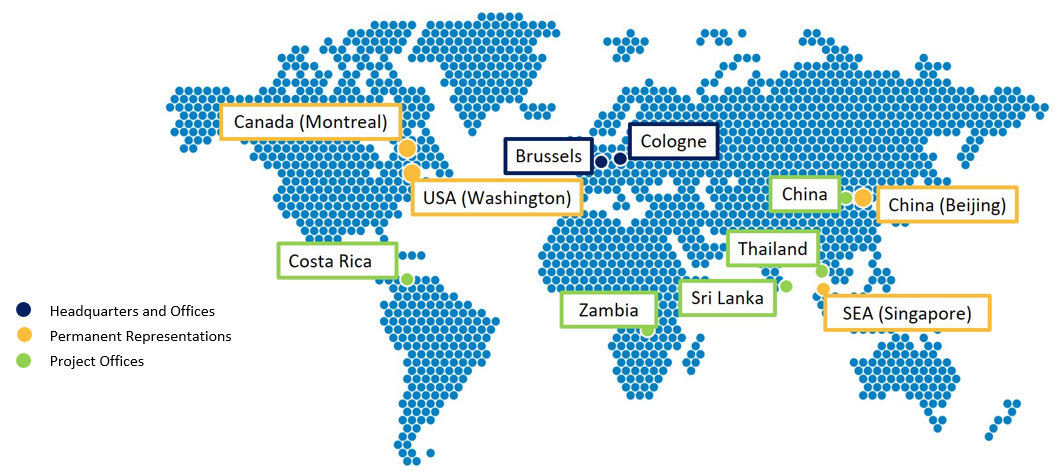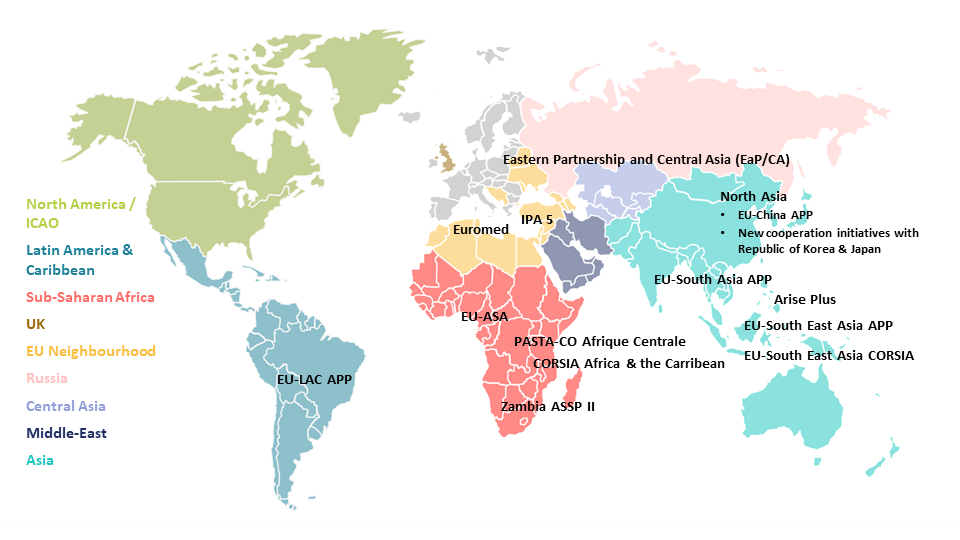EASA high-level strategic objectives for international cooperation in air safety
- Ensure that citizens’ safety interests are being met at global level
- Ensure a level playing field globally for European aviation industry
To meet these objectives, EASA partners with civil aviation authorities, regional and international organisations.
EASA offices, permanent representations & project offices

Aviation Safety Agreements & partners
What is a Bilateral Aviation Safety Agreement?
A Bilateral Aviation Safety Agreement (BASA) is signed between the EU (and its Member States) and a non-EU country. It aims at mutual acceptance of certificates. EASA supports the European Commission during the negotiation and implementation of such agreements.
Overview of BASAs in place
- United States, signature in 2008 - entry into force 2011
- Canada, signature 2009 - entry into force 2011
- Brazil, signature 2010 - entry into force 2013
- China, signature 2019
- Japan, signature 2020
- United Kingdom, signature 2020
What is a Working Arrangement?
A Working Arrangement (WA) is usually signed between EASA and the authority of a non-EU country, or a regional or international organisation. It covers matters of technical nature. It is typically used to facilitate EASA’s certification tasks or the validation by a foreign authority of EASA certificates. Unlike BASAs, these Working Arrangements do not allow for the mutual recognition of certificates. EASA directly negotiates and concludes such arrangements.
EASA currently has working & cooperation agreements with some 35 states in place.
EASA's Technical Cooperation regions & projects worldwide

What activities are covered?
- Enhance relations between non EU States and European institutions in the field of civil aviation
- Increase technical exchanges between non EU and European aviation industries
- Support those regions and Regional Safety Oversight Organisations in developing their capacity for safety oversight
- Improve the environmental performance of the aviation sector in those countries
EASA's working relations with International Civil Aviation Organization (ICAO)
Activities covered by working relations between EASA and ICAO:
- Coordination with the European Commission and EASA Member States on common positions on matters addressed at global level.
- Support for EASA Member States on the implementing of ICAO standards
- Exchange of safety information with ICAO to reduce the burden on EASA Member States during auditing activities
- Provision of technical expertise to ICAO activities, such as 50 ICAO panels, committees, working groups, study groups and task forces.
- Training for EASA staff as ICAO auditors and take part in USOAP audits (ICAO’s Universal Safety Oversight Audit Programme) in the EASA states and elsewhere.
- Contribution to the No Country Left Behind initiative, by coordinating its technical assistance activities with ICAO
What is a Regional Safety Oversight Organisation (RSOO)?
States put in place Regional Safety Oversight Organisations to collaborate, share best practices, safety oversight tasks and resources, with the aim to establish and maintain an effective aviation safety oversight system.
EASA is supporting ICAO in its RSOO activities. In Europe, EASA Member States agreed to cooperate in the area of aviation safety. EASA, as an Agency of the European Union, is an RSOO for Europe.
Other organisations and initiatives
EASA also works closely with a number of other aviation safety organisations and initiatives such as:
- SESAR, Single European Sky ATM Research
- Eurocontrol, pan-European, civil-military organisation supporting European aviation
- ESA, European Space Agency
- IATA, International Air Transport Association

